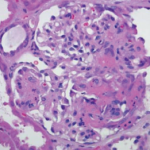An accumulation of replacement mutations can be observed in the complementarity determining 3 (CDR3) region of immunoglobulin genes, with these mutations serving as an indicator of selection and affinity maturation in germinal center-like structures of granulomatous lesions. Distinct offsprings of B lymphocyte clones in nasal mucosa indicated clonal expansion.29,30 Following laser-microdissection of single CD20+ tissue B cells, pairs of variable immunoglobulin light- and heavy-chain genes were isolated, sequenced, and cloned into corresponding vectors. Subsequently, these clones were recombinantly expressed using a baculovirus/insect cell system. Complete immunoglobulins were then tested for their antigen specificity. These studies identified autoantibodies directed against a transmembrane protein and a tetraspanin. Summarizing our initial experiments, we observed that the granulomatous lesion with its germinal center-like structures contains autoantibody-producing cells.30,31 Preliminary studies, detecting a frequent ANCA idiotype (5/7 Id), indicate the presence of PR3-ANCA-producing cell within the granulomatous lesion (unpublished data).
Previously, we demonstrated a predominance of T cells with a skewed Th1-type response in granulomatous lesions of localized WG, which was less prominent in generalized WG (see Figure 3, p. 43).28,32 Interestingly, in vitro co-cultures of PR3-exposed dendritic cells with autologous CD4+ T cells from patients with WG yielded a significantly higher production of interferon-gamma, which may be considered as the initiation of an adaptive immune response through PR3.33 Granulomatous lesions from generalized WG exhibited a Th2-type cytokine profile (see Figure 3, p. 43).34 Furthermore, it is assumed that Th17 cells participate in the pathogenesis of WG; it remains to be determined, however, if Th17 cells play a role in the granulomatous inflammation of WG.35 The current challenge to understand pathogenesis is to develop integrated models for the process of chronic inflammation that consider numerous feedback loops and regulatory networks in which T cell-derived cytokines operate in the granulomatous tissue.
Destruction Takes Place in the Granulomatous Lesion
Whereas damage of nasal cartilage and bone (see Figures 1 and 2, p. 41) is a well-known clinical feature of WG, the pathway of destruction is poorly understood. Some theories have postulated an ischemic etiology due to vasculitis; however, there has been no histopathological proof for mechanism. Moreover, despite cartilage or bone destruction, the majority of nasal granulomatous lesions in WG do not show a vasculitis.
To elucidate this important element of disease, tissue destruction in WG has been explored in a transfer model using immunodeficient pfp/rag2 -/- mice. In studies analogous to experimental models developed for rheumatoid arthritis, nasal biopsies of active WG were co-implanted together with healthy human cartilage. In contrast to controls, implants from nasal mucosa of patients with WG showed massive cartilage destruction mediated by human fibroblasts. It is assumed that matrix metalloproteases released by infiltrating fibroblasts are crucial for destruction. Interestingly, the destruction could be inhibited by corticosteroid treatment of the mice. To summarize the results of these experiments, this is the first model to indicate that inflamed nasal mucosa of patients with WG, resembling the cellular composition of the inflammatory infiltrate has destructive potential; and to provide evidence that destruction occurring in the respiratory tract is induced by a granulomatous cell infiltrate, not vasculitis. The model also implies that fibroblasts are the crucial cell type within granulomatous lesions that may be responsible for destruction.36
Conclusion
Summarizing the results from clinical studies, today we know that the granulomatous inflammation is associated with severe clinical complications. The complications include space-occupying masses leading to proptosis and blindness; destruction of surrounding tissue, cartilage and bone; and obstruction of the trachea (subglottic stenosis) and bronchi. A genetic predisposition may confer the formation of granulomatous lesions in WG. Summarizing the data from experimental (in vitro and in vivo) studies, granulomatous lesions may support the following pathogenic mechanisms: they may create a microenvironment for the induction of cartilage and bone destruction and the development of autoimmunity, eventually leading to the production of PR3-ANCA and to vasculitis. Despite major progress in disease treatment, important questions on pathogenesis remain: Why do granulomatous masses and lesions develop in WG? Additionally, why are there are patients who have only localized WG? Hopefully, future research will provide answers to these fundamental questions and lead to further improvement in the treatment of this serious and vexing disease.
Acknowledgment
We thank E. Csernok, K. Holl-Ulrich, F. Moosig, and P. Lamprecht for their critical discussion.
